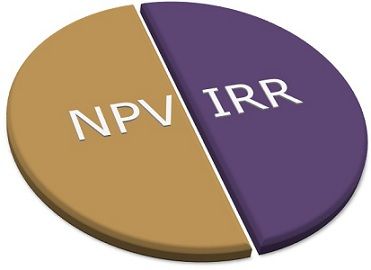 NPV or otherwise known as Net Present Value method, reckons the present value of the flow of cash, of an investment project, that uses the cost of capital as a discounting rate. On the other hand, IRR, i.e. internal rate of return is a rate of interest which matches present value of future cash flows with the initial capital outflow.
NPV or otherwise known as Net Present Value method, reckons the present value of the flow of cash, of an investment project, that uses the cost of capital as a discounting rate. On the other hand, IRR, i.e. internal rate of return is a rate of interest which matches present value of future cash flows with the initial capital outflow.
In the lifespan of every company, there comes a situation of a dilemma, where it has to make a choice between different projects. NPV and IRR are the two most common parameters used by the companies to decide, which investment proposal is best. However, in a certain project, both the two criterion give contradictory results, i.e. one project is acceptable if we consider the NPV method, but at the same time, IRR method favors another project.
The reasons of conflict amidst the two are due to the variance in the inflows, outflows, and life of the project. Go through this article to understand the differences between NPV and IRR.
Content: NPV Vs IRR
Comparison Chart
| Basis for Comparison | NPV | IRR |
|---|---|---|
| Meaning | The total of all the present values of cash flows (both positive and negative) of a project is known as Net Present Value or NPV. | IRR is described as a rate at which the sum of discounted cash inflows equates discounted cash outflows. |
| Expressed in | Absolute terms | Percentage terms |
| What it represents? | Surplus from the project | Point of no profit no loss (Break even point) |
| Decision Making | It makes decision making easy. | It does not help in decision making |
| Rate for reinvestment of intermediate cash flows | Cost of capital rate | Internal rate of return |
| Variation in the cash outflow timing | Will not affect NPV | Will show negative or multiple IRR |
Definition of NPV
When the present value of the all the future cash flows generated from a project is added together (whether they are positive or negative) the result obtained will be the Net Present Value or NPV. The concept is having great importance in the field of finance and investment for taking important decisions relating to cash flows generating over multiple years. NPV constitutes shareholder’s wealth maximization which is the main purpose of the Financial Management.
NPV shows the actual benefit received over and above from the investment made in the particular project for the time and risk. Here, one rule of thumb is followed, accept the project with positive NPV and reject the project with negative NPV. However, if the NPV is zero, then that will be a situation of indifference i.e. the total cost and profits of either option will be equal. The calculation of NPV can be done in the following way:
NPV = Discounted Cash Inflows – Discounted Cash Outflows
Definition of IRR
IRR for a project is the discount rate at which the present value of expected net cash inflows equates the cash outlays. To put simply, discounted cash inflows are equal to discounted cash outflows. It can be explained with the following ratio, (Cash inflows / Cash outflows) = 1.
At IRR, NPV = 0 and PI (Profitability Index) = 1
In this method, the cash inflows and outflows are given. The calculation of the discount rate, i.e. IRR, is to be made by trial and error method.
The decision rule related to the IRR criterion is: Accept the project in which the IRR is greater than the required rate of return (cut off rate) because in that case, the project will reap the surplus over and above the cut-off rate will be obtained. Reject the project in which the cut-off rate is greater than IRR, as the project, will incur losses. Moreover, if the IRR and Cut off rate are equal, then this will be a point of indifference for the company. So, it is at the discretion of the company, to accept or reject the investment proposal.
Key Differences Between NPV and IRR
The basic differences between NPV and IRR are presented below:
- The aggregate of all present value of the cash flows of an asset, immaterial of positive or negative is known as Net Present Value. Internal Rate of Return is the discount rate at which NPV = 0.
- The calculation of NPV is made in absolute terms as compared to IRR which is computed in percentage terms.
- The purpose of calculation of NPV is to determine the surplus from the project, whereas IRR represents the state of no profit no loss.
- Decision making is easy in NPV but not in the IRR. An example can explain this, In the case of positive NPV, the project is recommended. However, IRR = 15%, Cost of Capital < 15%, the project can be accepted, but if the Cost of Capital is equal to 19%, which is higher than 15%, the project will be subject to rejection.
- Intermediate cash flows are reinvested at cut off rate in NPV whereas in IRR such an investment is made at the rate of IRR.
- When the timing of cash flows differs, the IRR will be negative, or it will show multiple IRR which will cause confusion. This is not in the case of NPV.
- When the amount of initial investment is high, the NPV will always show large cash inflows while IRR will represent the profitability of the project irrespective of the initial invest. So, the IRR will show better results.
Similarities
- Both uses Discounted Cash Flow Method.
- Both takes into consideration the cash flow throughout the life of the project.
- Both recognize time value of money.
Conclusion
Net Present Value and Internal Rate of Return both are the methods of discounted cash flows, in this way we can say that both considers the time value of money. Similarly, the two methods, considers all cash flows over the life of the project.
During the computation of Net Present Value, the discount rate is assumed to be known, and it remains constant. But, while calculating IRR, the NPV fixed at ‘0’ and the rate which fulfills such a condition is known as IRR.






Dr Kannan says
Glad at least here is one article that clearly concluded the difference.
Shannon Laing says
This was a very simple way of explaining the differences between NPV and IRR. This is not an easy concept to grasp, but this article was able to break it down into a more understandable format. Thank you very much. Please continue to produce informative and helpful financial information such as this, for those of us that are not investors but want to learn.
Surbhi S says
Thank you so much for your appreciation, your reviews help us to do even better. Keep visiting 🙂
Sanjay Desai says
Superb! Kindly take a step further and let us know IRR Vs. XIRR.
Is it the same thing as your IRR Vs. MIRR? The context is SIP investments in Mutual Funds.
Johnston Ngezimana says
thank you very much i managed to get what i am looking for ny assignment.
Shakti says
Your page never disappoints me. It has always helped me in my studies…keep doing this great work. Thanks a lot for your easy explanations..
Sospeter says
Thanks, your post has made me understand the investment criteria IRR I never understood before